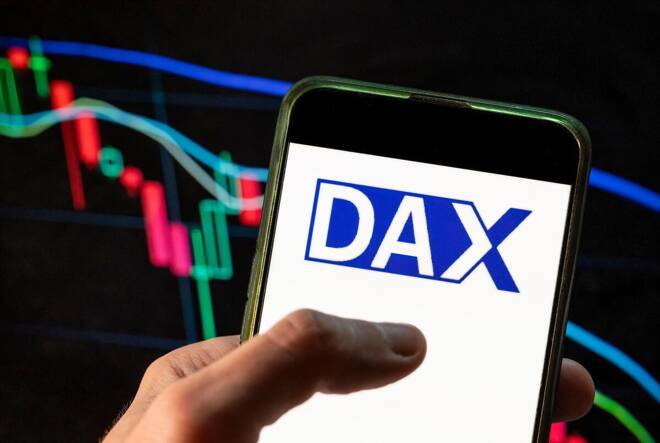Advertisement
Advertisement
DAX Set for a Choppy Monday as China Economy Slows in Q2
By:
It is a busy start to the week for the DAX, with economic indicators from China and ECB commentary to set the tone after the gains from last week.
Highlights
- It was a bearish end to a bullish week for the DAX on Friday, falling 0.22% to end the day at 16,105.
- Corporate earnings and forward guidance left the DAX on the back foot.
- Ahead of the European opening bell today, economic indicators from China set the tone this morning.
It was a bearish Friday session for the DAX, which fell 0.22%. Partially reversing a 0.74% gain from Thursday, the DAX ended the week up 3.22% to 16,105. Significantly, the DAX ended a five-day winning streak.
Economic indicators from Germany weighed on market risk sentiment early in the European session. However, better-than-expected consumer sentiment figures from the US failed to deliver a late rally. US corporate earnings and forward guidance weighed on investor sentiment late in the session.
Citigroup (C) reported a slide in quarterly profits, with Blackrock (BLK) reporting a decline in quarterly revenue. JPMorgan (JPM) and Wells Fargo (WFC) beat estimates but announced increased provisioning for expected losses from commercial real estate (CRE) loans.
The NASDAQ Composite Index and the S&P 500 saw losses of 0.18% and 010%, respectively, while the Dow gained 0.33%.
German Wholesale Inflation Overshadows US Optimism
It was a relatively quiet day on the European economic calendar. German wholesale inflation figures for June drew interest early in the European session.
However, the numbers were bearish, with wholesale prices falling 2.9% year over year in June versus a 2.6% decline in May. Economists forecast a 1.2% decline. The wholesale price index fell by the most marked amount since June 2020. However, the index saw a modest 0.2% monthly fall in June versus a forecasted 1.2% fall.
Later in the session, trade data for the Eurozone provided little comfort. The trade deficit narrowed from €12.0 billion to €0.3 billion in May. Exports of goods to the rest of the world fell by 2.3% compared with May 2022, while imports tumbled by 12.8%.
US economic indicators were bullish but failed to support a bullish end to the Friday session, with mixed corporate earnings weighing.
According to prelim figures, the Michigan Consumer Sentiment Index jumped from 64.4 to 72.6 in July versus a forecasted 65.5. Stable labor market conditions and softer inflationary pressures supported the pickup in consumer sentiment.
The Market Movers
It was a mixed session for the auto sector. Mercedes-Benz Group and Volkswagen fell by 0.51% and 0.60%, respectively, with BMW and Continental AG ending the day down 0.22% and 0.11%, respectively. Porsche bucked the trend, gaining by 0.11%.
It was also a mixed session for the banks. Commerzbank slid by 1.65%, while Deutsche Bank gained 0.18%.
The Day Ahead for the DAX
This morning, economic indicators from China set the tone for the day, with Q2 GDP, industrial production, and retail sales drawing interest.
The Chinese economy expanded by 0.8% in the second quarter and by 6.3% year-over-year. Economists forecast the Chinese economy to grow by 7.3% year-over-year but by just 0.5% in the second quarter.
Industrial production and fixed asset investment numbers were hotter than expected. Industrial production increased by 4.4% year-over-year in June versus 3.5% in May. Fixed asset investments were up 3.8% in June versus 4.0% in May. Economists forecast industrial production and fixed asset investment to increase by 2.7% and 3.5%, respectively.
However, retail sales numbers disappointed, rising by 3.1% in June versus a forecasted 3.2% increase. In May, retail sales were up 12.7% year-over-year.
The markets took the year-on-year GDP miss as bearish, leaving the DAX futures in the red this morning.
It is a quiet day on the European calendar. Finalized inflation numbers for Italy are out but will unlikely influence market risk sentiment.
However, ECB commentary will need consideration. ECB President Christine Lagarde and Chief Economist Philip Lane are on the calendar to speak today with investors looking for post-summer forward guidance
It is a quiet day on the US economic calendar. NY Empire State Manufacturing numbers for July will be in focus. However, barring a sharp decline, we do not expect the report to influence market risk sentiment.
According to the ISM survey, the US manufacturing sector contracted for the eighth consecutive month in June. The numbers from New York State would have to be particularly weak to draw interest.
While the economic calendar is on the light side, there are no FOMC member speeches to consider. The Fed went into the blackout period on July 15.
DAX Technical Indicators
Looking at the EMAs and the 4-hourly chart, the EMAs sent bullish signals. The DAX sat above the 50-day (15,943) and 200-day (15,846) EMAs, signaling bullish momentum over the near and longer term. Significantly, the 50-day EMA pulled away from the 200-day EMA, sending bullish signals and supporting a hold above the upper level of the 16,000 – 16,080 resistance band.
A continued hold above the 16,000 – 16,080 resistance band would bring the July high of 16,209 into play. However, central bank chatter must be DAX-friendly to support a bullish session as investors respond to the stats from China.
A fall through the upper level of the 16,000 – 16,080 resistance band would bring sub-16,000 and the 50-day EMA (15,943) into view.
The 14-4H RSI sits at 64.56, sending bullish signals. Significantly, the RSI aligns with the EMAs, supporting a run at the 16,209 July high.
For a look at the economic events, check out our economic calendar.
About the Author
Bob Masonauthor
With over 28 years of experience in the financial industry, Bob has worked with various global rating agencies and multinational banks. Currently he is covering currencies, commodities, alternative asset classes and global equities, focusing mostly on European and Asian markets.
Advertisement
